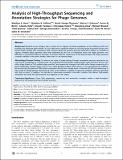Analysis of High-Throughput Sequencing and Annotation Strategies for Phage Genomes
Author(s)
Chisholm, Sallie (Penny); Sullivan, Matthew B.; Birren, Bruce W.; Nusbaum, Chad; Young, Sarah K.; Giannoukos, Georgia; Saif, akina; Sparrow, Todd; Weiand, Michael; Zeng, Qiandong; Kodira, Chinnappa D.; Yandava, Chandri; Kelly, Libusha; Berlin, Aaron M.; Osburne, Marcia; Stange-Thomann, Nicole; Henn, Matthew R.; ... Show more Show less
DownloadHenn-2010-Analysis of high-thr.pdf (794.9Kb)
PUBLISHER_POLICY
Publisher Policy
Article is made available in accordance with the publisher's policy and may be subject to US copyright law. Please refer to the publisher's site for terms of use.
Terms of use
Metadata
Show full item recordAbstract
Background: Bacterial viruses (phages) play a critical role in shaping microbial populations as they influence both host mortality and horizontal gene transfer. As such, they have a significant impact on local and global ecosystem function and human health. Despite their importance, little is known about the genomic diversity harbored in phages, as methods to capture complete phage genomes have been hampered by the lack of knowledge about the target genomes, and difficulties in generating sufficient quantities of genomic DNA for sequencing. Of the approximately 550 phage genomes currently available in the public domain, fewer than 5% are marine phage.
Methodology/Principal Findings: To advance the study of phage biology through comparative genomic approaches we used marine cyanophage as a model system. We compared DNA preparation methodologies (DNA extraction directly from either phage lysates or CsCl purified phage particles), and sequencing strategies that utilize either Sanger sequencing of a linker amplification shotgun library (LASL) or of a whole genome shotgun library (WGSL), or 454 pyrosequencing methods. We demonstrate that genomic DNA sample preparation directly from a phage lysate, combined with 454 pyrosequencing, is best suited for phage genome sequencing at scale, as this method is capable of capturing complete continuous genomes with high accuracy. In addition, we describe an automated annotation informatics pipeline that delivers high-quality annotation and yields few false positives and negatives in ORF calling.
Conclusions/Significance: These DNA preparation, sequencing and annotation strategies enable a high-throughput approach to the burgeoning field of phage genomics.
Date issued
2010-02Department
Massachusetts Institute of Technology. Department of Civil and Environmental EngineeringJournal
PLoS ONE
Publisher
Public Library of Science
Citation
Henn MR, Sullivan MB, Stange-Thomann N, Osburne MS, Berlin AM, et al. (2010) Analysis of High-Throughput Sequencing and Annotation Strategies for Phage Genomes. PLoS ONE 5(2): e9083. doi:10.1371/journal.pone.0009083
Version: Final published version
ISSN
1932-6203